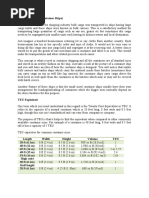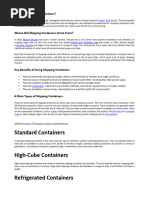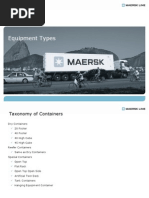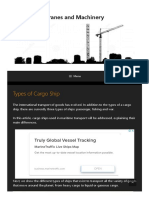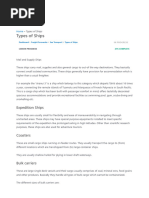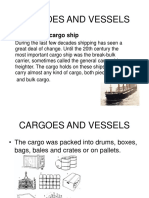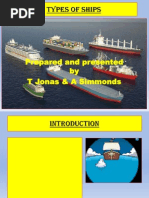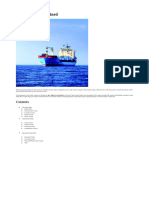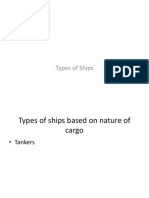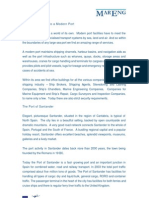Equipment
Equipment
Uploaded by
Ирина ГригорьеваCopyright:
Available Formats
Equipment
Equipment
Uploaded by
Ирина ГригорьеваCopyright
Available Formats
Share this document
Did you find this document useful?
Is this content inappropriate?
Copyright:
Available Formats
Equipment
Equipment
Uploaded by
Ирина ГригорьеваCopyright:
Available Formats
Types and sizes of containers
Types of Sea large-capacity containers (General purpose) containers vary in type and size.
For any kind of cargo you can choose the container most appropriate to its parameters. The massive use got
the standard, so-called "dry" containers (DC - Dry Container):
- For the transport of "dense" or heavy goods of small size are more suitable for 20-foot containers;
- lightweight, but the bulk of the cargo 40 ' standard or high (High Cube) containers;
in addition to these, there are other types of containers, such as:
Refrigerated containers used for goods requiring compliance with temperature regime;
Oren tor (instead of a hard roof soft awning) - easy to load from above;
Flat Rack (open area) - for the transport of oversized cargo;
Tank containers (Tank) for liquid and gaseous substances;
A short history to shipping container dimensions
The idea of loading merchandise onto trucks, then moving onto trains or ships and
then loading them back onto trucks came about over 60 years ago. It originated from
a small-time truck hauler by the name of Malcolm McLean from Maxton, North
Carolina.
McLean greatly improved this process by placing merchandise into containers so that
entire containers can be lifted and loaded from the chassis. The next step was to
standardize the shipping container dimensions for easy handling by trucks, trains,
ships and ports around the world.
This standardization of shipping container dimensions made a substantial
global impact on world trade. It allowed manufacturers to load goods at their
factories and ship directly to stores and warehouses without having to unload and
transfer their cargo along the way. This meant that manufacturing processes could be
located far away from customers but still provide customers with an unimaginable
variety of low-cost goods from across the globe. Today, there are 5,000 freighters
carrying over 14 million containers to ports all over the world.
Types of containers and their dimensions: which is best
for you
ISO standard containers have been customized to meet the demands of exporters and
importers in international trade. With 12 different ocean shipping container types and
a variety of sizes to choose from within those types, it’s possible to ship everything
from bulk grains and raw materials to perishable commodities. If you want to know
the space required for your cargo, check our cubic meter calculator.
CALCULATE OCEAN FREIGHT
In this guide, we will walk you through the different ocean container types
and their shipping container dimensions including:
20 ft dry shipping container
40 ft dry shipping container
40 ft dry high cube shipping container
45 ft dry high cube shipping container
20 ft flat rack shipping container
40 ft flat rack shipping container
20 ft open top shipping container
40 ft open top shipping container
20 ft ventilated shipping container
20 ft refrigerated shipping container
40 ft refrigerated shipping container
20 ft tank shipping container
Standard shipping container dimensions
The 20 ft standard shipping container and the 40 ft standard shipping container are
two of the most widely used containers in the world to transport ocean freight goods.
The standard shipping containers differ from other types of containers in that they are
completely airtight. These hermetically sealed shipping containers are not equipped
with cooling nor ventilation systems like the refrigerated and ventilated containers.
The 20 ft standard shipping container can hold up to 10 standard pallets or 11 Euro
pallets across its floor base.
The standard shipping containers are also known as dry shipping containers or dry
vans.
Ventilated shipping container dimensions
The 20 ft ventilated container is a shipping container that offers a ventilation system
due to its lateral openings that permit air flow and circulation.
These characteristics make it suitable for the transportation of goods that require
constant temperature and conditions.
Thanks to its ventilation system, the 20 ft ventilated container is able to expel hot air
and allow fresh air to enter, thus preventing condensation and humidity changes that
may damage the cargo.
One of the main products transported in the ventilated container is coffee, which is
why it may also sometimes also be known as the “coffee container”.
Refrigerated shipping container dimensions
Refrigerated shipping containers, also known as reefer containers, are equipped with
a system that helps to maintain an internal temperature of between -25º and + 25º.
Contrary to popular belief, these refrigerated containers do not regulate
temperatures, they can only maintain them.
There are certain types of refrigerated containers that are capable of maintaining
temperatures as low as -60º.
Although refrigerated containers have integrated systems that help with maintaining
the internal temperature, the container must be connected to an external power
source such as the vessel’s generator or the port’s power supply.
When booking a reefer container, it is important to make sure that necessary
equipment is available throughout the entire international transport chain (from pick
up to drop off) to help power the container and maintain its internal temperature.
Reefer containers are most commonly used to transport fresh and frozen foods such
as fish, meat, fruits, and other perishable items. It is also regularly used to transport
medicines and pharmaceutical products.
Flat rack shipping container dimensions
Flat rack shipping containers are designed to transport merchandise whose overall
measurements and/or weight prevent them from fitting into a standard container.
These containers are made of metal plates that fit a standard structure of 20 or 40
feet. Its sides are collapsible and it does not have a roof or top. This makes it easy for
top- or side-loading. Such features make flat rack containers suitable for transporting:
Heavy or over-sized cargo such as construction equipment, building supplies or
heavy machinery. These cargoes usually need to be loaded onto the flat rack
with a crane or other special equipment.
Goods with a height higher than that of a 20 or 40 ft high cube container or
irregularly shaped goods such as industrial vehicles or pipes.
Because the flat rack container has no side or top to protect the cargo, extra care
must be taken to prevent damage by weather conditions such as heavy rain or strong
winds. Lashing the cargo will help secure the cargo and make sure it stays in its place.
When booking a flat rack shipping container, make sure to clearly indicate lifting
points for your over- or odd-sized cargo to avoid damages — especially for heavy
machinery. Remember to also specify any special handling instructions to your freight
forwarder.
Open top shipping container dimensions
Open top containers, be it 20 ft or 40 ft, fall within the category of standard
containers, despite not having a roof.
The type of goods typically transported in open top containers is essentially the same
as those being transported in flat rack containers, but with more irregular heights.
Some examples include goods that are too heavy for manual handling and must be
lifted and loaded with a crane, or top-protruding merchandise that cannot fit into a 40
ft high cube standard container.
Unlike the flat rack, which also has no roof, open top containers have walls to protect
the goods. A tarpaulin will be needed to cover the top to protect the merchandise.
Note that the opening of an open top shipping container through which you load your
cargo is slightly smaller than the container’s interior. This is similar to the door of a
regular container and it’s for structural integrity purposes. In other words, there is less
room to work with for maneuvering when loading your cargo through the top of an
open top shipping container.
A 20 ft open top container has a maximum load of approximately 28 metric tons,
while the 40 ft open top container can hold up to 30 metric tons.
Due to low demand for open top containers, some carriers may find it difficult to
secure cargo requiring open top containers to be able to send the containers back to
the origin. As such, carriers may implement an extra cost to transport open top
containers, which can vary according to the destination.
When booking an open top shipping container, make sure lifting points for your over-
or odd-sized cargo are well-indicated to avoid damages and specify handling
instructions to your freight forward.
ISO tank shipping container dimensions
ISO tank or ISO containers are containers specially designed to transport liquids or
gases. They can hold bulk cargoes ranging from perishable liquids such as oil or wine
to hazardous substances.
Additional requirements will need to be fulfilled when shipping hazardous substances
in ISO tanks. And once an ISO tank has been tagged to ship hazardous substances, it
can no longer be used to ship food, and vice versa.
The ISO tank is supported on a structure that can be adjusted according to its
dimensions. It’s also lined with an insulating material that protects it from the cargo
it’s transporting.
ISO tanks offer one of the most effective intermodal transportation methods for bulk
cargo. They are safer, offer more flexibility, are more environmentally friendly, and
relatively cheaper than other options such as OTR tank trucks.
The most commonly used ISO tanks measure 20 or 40 ft there are also 10 and 30 ft
long ISO tanks. They’re also widely known as ISO containers or tank containers.
How to quote and book non-standard shipping containers
At iContainers, we offer the 20 ft and 40 ft standard container, as well as the 40 ft
high cube standard container. You may get your quote for any of these types of
containers in seconds by searching on our website.
If shipping irregular cargo, the dimensions and weight of the merchandise determine
which ocean container type can best accommodate your shipment. This information
and a photograph or spec sheet must be submitted to your freight forwarder, who will
handle the booking with the shipping line. They will then give you a detailed
assessment of fees and customize your cargo solution.
If you’re interested in booking other ocean shipping container types, please contact
our sales representatives.
Each cargo has specific requirements for the containers used for transportation. The several types of containers are
specially designed for those requirements.
It is a responsibility of the shipper to ensure, that transportation requirements of your cargo are fulfilled, i.e. to make
sure the goods are packed and stowed in the right container and safe conditions and he must inspect it previously for
the effect.
Depending on various factors, dimensions and capacity of each container of same type may be slightly different. The
maximum payload of each container furthermore depends also on legal road limitations and/or on the handling
capacity of all ports in all countries crossed between Origin and Destination. You must therefore consult us when
booking a container. Transcinco can assist you with more useful information.
8 minutes to read
Shipping containers across the globe sizes follow the international standard called the ISO
(Industrial Standards Organisation). These containers have been created specifically to
meet the demands of exporters and importers in international trade. There are twelve
different categories of ISO containers and a variety of types to choose from within those
categories, it’s possible to ship everything from bulk grains and raw materials to perishable
commodities.
HOW DO I KNOW WHICH CONTAINER TO USE?
The various types of shipping containers have identifying serial numbers that act as a mark
to helps shippers and freight forwarders track containers as they move through the
shipping process.
The identifying mark vary and are combined of the following:
The first three letters are the owner code, that is an abbreviation for the name of the
owner of the container and is registered with the ICB (International Container
Bureau).
The fourth letter is known as the product code: U for all freight containers; J for
detachable freight container equipment and; Z for trailers and chassis.
The following six digits represent the registration number assigned by the owner
operator to each container in their fleet.
The final digit is the check digit, placed in brackets. This is a control number used to
verify the owner, product code, and serial number.
There is also an identifying code for the container type, the tare weight (weight of
the empty container), gross weight and maximum payload.
The different shipping containers sizes and their dimensions are outlined below:
HOW ARE SHIPPING CONTAINERS CONSTRUCTED?
Containers are built from thick non-corrosive steel and square tubing frame. The sides are
built from 14 gauge, non-corrosive rolled steel that is corrugated to add rigidity and then
welded to the steel frame.
The floor of containers are made of the same square steel tubing for the frame and a thick
plywood floor attached to the cross braces.
The corner posts are designed to take the weight of nine containers stacked on top of one
another. Each container has a door opening at one end.
Standard containers are 20’ x 8’ x 8’6”, However, the 40-foot and 45-foot containers are
becoming just as common. An empty 20-foot container weighs approximately 5,500 pounds
and can carry 65,000 pounds of goods.
When talking about containers the cargo statistics are calculated in TEU (20-foot equivalent
units). Therefore, a 20 foot container would be 1 TEU, a 40-foot container would be 2 TEUs
and so on. As newer super freighters become more commonplace, the sizes of containers
are increasing as well, with some measuring as long as some as long as 57ft.
In Europe however, it’s worth noting that the larger sized containers are frown upon
because of the older and more narrow streets in many European cities make it difficult for
large trucks to navigate. This has been known to cause numerous congestions.
Please contact our sales team if you would like more information about container shipping.
You might also like
- 2008 Nissan Maxima Wiring DiagramsDocument99 pages2008 Nissan Maxima Wiring Diagramsmike100% (1)
- SM-JCB 1CX, 1CXT Backhoe Loader Service Repair Manual 9813-6050Document1,124 pagesSM-JCB 1CX, 1CXT Backhoe Loader Service Repair Manual 9813-6050Darren100% (3)
- Cummins ISX-CM870: Electrical Circuit DiagramDocument12 pagesCummins ISX-CM870: Electrical Circuit DiagramGus Salazar100% (12)
- Container Familiarization Course1Document48 pagesContainer Familiarization Course1andrija100% (2)
- Introduction of Iso Tank ContainersDocument10 pagesIntroduction of Iso Tank ContainerswenigmaNo ratings yet
- CHS Unit - VDocument54 pagesCHS Unit - VKannanNo ratings yet
- Classification of ContainersDocument4 pagesClassification of Containersrm3237177No ratings yet
- ContainerDocument9 pagesContainerHarsh DaveNo ratings yet
- What Is The TEUDocument4 pagesWhat Is The TEUMohd Nur FaizNo ratings yet
- What Is Containerization and Explain Its Various TypesDocument4 pagesWhat Is Containerization and Explain Its Various Typesshivamdubey12No ratings yet
- Containers and Its TypesDocument25 pagesContainers and Its TypesAbu BasharNo ratings yet
- Containers: Containerisation: This Is A Practice of Grouping Loads of Cargo Together in Standard Size SteelDocument7 pagesContainers: Containerisation: This Is A Practice of Grouping Loads of Cargo Together in Standard Size SteeljejeNo ratings yet
- Different Types of Containers Used in International Trade: Logistic Presentation TemplateDocument12 pagesDifferent Types of Containers Used in International Trade: Logistic Presentation TemplatejovenrossfilesNo ratings yet
- Container TypeDocument3 pagesContainer TypeNoparit KittisatitNo ratings yet
- Storage Container: The Complete Handbook of Container Types and MaintenanceFrom EverandStorage Container: The Complete Handbook of Container Types and MaintenanceNo ratings yet
- 1) ContainerDocument25 pages1) ContainerAhmadreza HelaliNo ratings yet
- Container Stowage DeckDocument29 pagesContainer Stowage DeckRamin Soad100% (1)
- ContainerizationDocument35 pagesContainerizationyash sankheNo ratings yet
- Containers: Integrands: Tatiana Gaitán Ashly Solís Aldo Rivera Andrea Villamonte Liz CoronadoDocument17 pagesContainers: Integrands: Tatiana Gaitán Ashly Solís Aldo Rivera Andrea Villamonte Liz CoronadoLizmarie CoronadoNo ratings yet
- Question 1Document11 pagesQuestion 1Di AnNo ratings yet
- Sea FreightDocument19 pagesSea Freightlucyelizabeth606No ratings yet
- About ContainersDocument22 pagesAbout ContainersAjeet KrishnamurthyNo ratings yet
- Cargo Handling - 2-3 FNDNFDocument55 pagesCargo Handling - 2-3 FNDNFDora Deniz HalıcıNo ratings yet
- Lesson 2 SHIP TYPESDocument11 pagesLesson 2 SHIP TYPESNelton Xadreque NhachungueNo ratings yet
- Material 2 MOST COMMON CONTAINER TYPESDocument15 pagesMaterial 2 MOST COMMON CONTAINER TYPESIjoen'sNo ratings yet
- Cargo-Containers: A Documentation by Jaro Cools 9161404 Sept.2005Document15 pagesCargo-Containers: A Documentation by Jaro Cools 9161404 Sept.2005MIRCEA1305100% (1)
- GSK 2Document10 pagesGSK 2KannanNo ratings yet
- Types of Cargo ShipDocument20 pagesTypes of Cargo ShipNIKE IKA NUZULANo ratings yet
- Container's OperationDocument30 pagesContainer's OperationNguyễn HiếuNo ratings yet
- Types of Ships - Container ShipsDocument15 pagesTypes of Ships - Container Shipssh1minhNo ratings yet
- Tmce 3Document24 pagesTmce 3lopezibethizamarNo ratings yet
- Types of Ships –Document6 pagesTypes of Ships –rm3237177No ratings yet
- Cargoes and Vessels: The General Cargo ShipDocument31 pagesCargoes and Vessels: The General Cargo ShipCatalin Apetre100% (3)
- Ahmad 'Aliy Nurnaim Bin Alial Mulub Muhammad Hakim HaikalDocument21 pagesAhmad 'Aliy Nurnaim Bin Alial Mulub Muhammad Hakim HaikalKhairil AzmanNo ratings yet
- Types of Road Freight Transport –Document7 pagesTypes of Road Freight Transport –rm3237177No ratings yet
- Types of ShipsDocument19 pagesTypes of ShipsDreamgirl Chrisy G100% (2)
- CONEX Containers - History, Dimensions, Features and UsesDocument7 pagesCONEX Containers - History, Dimensions, Features and UsesGiorgi KandelakiNo ratings yet
- Container ShipsDocument7 pagesContainer ShipskrenariNo ratings yet
- Types of Container ShipsDocument5 pagesTypes of Container ShipsZyntackNo ratings yet
- Ship's NomenclatureDocument21 pagesShip's NomenclatureGennieNo ratings yet
- Types of Ship and Port Material Handling Equipment & TechnologyDocument36 pagesTypes of Ship and Port Material Handling Equipment & TechnologyKaren Shui100% (20)
- General Question and AnswersDocument17 pagesGeneral Question and AnswersSabih MunirNo ratings yet
- I. General Cargo Ships (Sometimes Called Breakbulk Carriers)Document1 pageI. General Cargo Ships (Sometimes Called Breakbulk Carriers)Lucila AlonsoNo ratings yet
- Bulk Carrier LiteratureDocument23 pagesBulk Carrier LiteratureJeesonAntony100% (1)
- ShipsDocument4 pagesShipsHUNG NIKKONo ratings yet
- Vessel Types ExplainedDocument6 pagesVessel Types Explainedrifqi mubarokNo ratings yet
- Container ShipsDocument34 pagesContainer ShipsMia Anjelika Francia100% (3)
- Cargo Types and ContainerDocument18 pagesCargo Types and ContainerRani Dispota100% (1)
- Problemario Mecanica de Los FluidosDocument10 pagesProblemario Mecanica de Los FluidosLeonardo AraujoNo ratings yet
- Logistics Management - PPTDocument3 pagesLogistics Management - PPTharshulNo ratings yet
- Cargo Handling PortDocument29 pagesCargo Handling PortHarry PasaribuNo ratings yet
- Cargo Care - Container TalkDocument8 pagesCargo Care - Container TalkmkbNo ratings yet
- Different Types of Bulk CarriersDocument2 pagesDifferent Types of Bulk CarriersGemsNo ratings yet
- Types of Shipping ContainersDocument3 pagesTypes of Shipping ContainersDixon SotamboNo ratings yet
- Types of ShipsDocument37 pagesTypes of ShipsBalaji kNo ratings yet
- UNIT 2 Welcome To A Modern Port: The Port of SantanderDocument6 pagesUNIT 2 Welcome To A Modern Port: The Port of SantanderIban Santana HernandezNo ratings yet
- Types of ShipsDocument7 pagesTypes of ShipsMitanshu ChadhaNo ratings yet
- Types of Ships Read For LeisureDocument2 pagesTypes of Ships Read For Leisurehenninour23No ratings yet
- Containers: Different KindsDocument11 pagesContainers: Different KindsRene SilvaNo ratings yet
- Trucks TypeDocument2 pagesTrucks TypeMani MentalNo ratings yet
- Shipping Container Homes: Steps And Strategies To Building Or Buying Your Own Dream Shipping Container HomeFrom EverandShipping Container Homes: Steps And Strategies To Building Or Buying Your Own Dream Shipping Container HomeNo ratings yet
- Marine Logistics including Liquid Cargo and Bulk CargoFrom EverandMarine Logistics including Liquid Cargo and Bulk CargoRating: 3 out of 5 stars3/5 (1)
- Shipping Container Homes: How to build a shipping container home, including plans, cool ideas, and more!From EverandShipping Container Homes: How to build a shipping container home, including plans, cool ideas, and more!No ratings yet
- MANEX A320 FCOM/FCTM v2Document109 pagesMANEX A320 FCOM/FCTM v2Renan SallesNo ratings yet
- Explanatory Note Environmental FeesDocument1 pageExplanatory Note Environmental FeesGarry A. CabotajeNo ratings yet
- Freight ForwardingDocument37 pagesFreight ForwardingSugi YantiNo ratings yet
- Checklist-SWF OHC 1Document3 pagesChecklist-SWF OHC 1Yuniar WidyaNo ratings yet
- 430-FMS-35 Cockpit Voice RecorderDocument16 pages430-FMS-35 Cockpit Voice RecorderLavern SipinNo ratings yet
- MSC Res 500 105 IMSBC Code Amendments 2024Document23 pagesMSC Res 500 105 IMSBC Code Amendments 2024mlaouhi MajedNo ratings yet
- Samp LogDocument2 pagesSamp LogItalo SilvaNo ratings yet
- Weekly Work Done - DeckDocument9 pagesWeekly Work Done - DeckGogiNo ratings yet
- Summary TUTBDocument4 pagesSummary TUTBTiwi WidyaNo ratings yet
- DRIVE UNIT ComponentsDocument2 pagesDRIVE UNIT ComponentsDaniel PopescuNo ratings yet
- Ticket TK442550863Y67Document3 pagesTicket TK442550863Y67devcode12345No ratings yet
- Manipon Chapter 4,5 NewDocument7 pagesManipon Chapter 4,5 Newelizabeth monasterioNo ratings yet
- Dersnot 4611 1585118703 PDFDocument27 pagesDersnot 4611 1585118703 PDFBatuhan AlgürNo ratings yet
- Biller HachimDocument2 pagesBiller HachimhachimmasmiaNo ratings yet
- Manage Your Booking - FlydubaiDocument1 pageManage Your Booking - Flydubaimanishuae151No ratings yet
- ZOM 11300 1 Electrical RHGSE Operating ManualDocument46 pagesZOM 11300 1 Electrical RHGSE Operating ManualmecambNo ratings yet
- Dmyi 000060Document2 pagesDmyi 000060mohammadfarsiinfoNo ratings yet
- Christopher ColumbusDocument14 pagesChristopher ColumbusPassant RashwanNo ratings yet
- 2021 Toyota InnovaDocument12 pages2021 Toyota Innovabutata02No ratings yet
- Leaslebl PDF 1701387787Document22 pagesLeaslebl PDF 1701387787Vicenç CNo ratings yet
- HD11 - Ship SpecificationDocument1 pageHD11 - Ship SpecificationLuu Quang HoaNo ratings yet
- Slide FOCDocument17 pagesSlide FOCadriana farnizaNo ratings yet
- Vehicle Standards Information No. 9: Guidelines For Alternative Wheels and TyresDocument7 pagesVehicle Standards Information No. 9: Guidelines For Alternative Wheels and TyresDani DaniNo ratings yet
- Bridge Load Rating Manual: Connecticut Department of TransportationDocument81 pagesBridge Load Rating Manual: Connecticut Department of TransportationDaisy' RuizNo ratings yet
- Data Sheet Pipa - HoistcraneDocument15 pagesData Sheet Pipa - HoistcranemadonxgoreNo ratings yet
- Inv 10 May 23Document58 pagesInv 10 May 23lefrenchg1No ratings yet
- RCBII RSL Parameters - 4767764251226047386845665916 PDFDocument67 pagesRCBII RSL Parameters - 4767764251226047386845665916 PDFBartz Santos50% (2)








